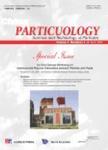L-S mass transfer in G-L-S countercurrent magnetically stabilized bed with amorphous alloy SRNA-4 catalyst
L-S mass transfer in G-L-S countercurrent magnetically stabilized bed with amorphous alloy SRNA-4 catalyst作者机构:School of Chemical Engineering Tianjin University Tianjin 300072 China Research Institute of Petroleum Processing SINOPEC Beijing 100083 China
出 版 物:《China Particuology》 (CHINA PARTICUOLOGY)
年 卷 期:2007年第5卷第1期
页 面:116-120页
核心收录:
学科分类:081705[工学-工业催化] 08[工学] 0817[工学-化学工程与技术] 0805[工学-材料科学与工程(可授工学、理学学位)] 0702[理学-物理学]
基 金:中国石油化工股份有限公司项目 973 Program (2006CB202500) The authors are grateful for the financial support from NSFC (20676096)
主 题:Magnetically stabilized bed Countercurrent Liquid-solid mass transfer SRNA-4 catalyst
摘 要:Liquid-solid (L-S) mass transfer coefficients (Ks) were characterized in a gas-liquid-solid (G-L-S) three-phase countercurrent magnetically stabilized bed (MSB) using amorphous alloy SRNA-4 as the solid phase. Effects of superficial liquid velocity, superficial gas velocity, magnetic field strength, liquid viscosity and surface tension were investigated. Experimental results indicated that the external magnetic field increased Ks in three-phase MSB, as compared to those in conventional G-L-S fluidized beds; that Ks increased with magnetic field strength, superficial gas and liquid velocities and decreased with liquid viscosity and surface tension; and that Ks showed uniform axial and radial distributions except for small increases close to the wall. Dimensionless correlations were established to estimate Ks of the G-L-S countercurrent MSB using SRNA-4 catalyst, with an average error of 3.6%.



